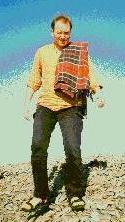

PhD Title: 'The use of marine bivalve molluscs as indicators of palaeoenvironmental conditions '
Supervisors: Dr William Perkins and Dr Nick Pearce.
Start Date: September 1997.
Finish Date: September 2000
Nature of Research:
Some of the research I undertake is not only fabulously interesting but also has a marvellous overall descriptor 'Sclerochronology' which is the marine equivalent of Dendrochronology.
Sclerochronology relies on the phenomenon of cyclic elemental and isotopic patterns produced in the shells and hard parts of marine organisms which reflect their environment of deposition. Of specific interest to my research are the marine molluscs, Arctica Islandica (Linneaeus, 1767); the Ocean Quahog. These molluscs are the oldest extant molluscs of an ancient genus , which has its origins the the Cretaceous, they can live for over 200 years, thus providing a valuable record of palaeoenvironmental conditions.
Of equal interest are the bivalve molluscs Mercenaria mercenaria and Mercenaria campechiensis, the Northern and Southern Quahog, which like Arctica, reflect their environment of deposition, though on timescale of 20-30 years.
My research concentrates on ultra high resolution elemental analyses, within biogenic carbonates, using UV LA-ICP-MS and stable isotope analysis. The results are then used as proxies for environmental parameters such as temperature, productivity and seasonality, from both present day and fossil molluscs.
Below are a list of papers, articles and presentations
Grattan J, Abu Karaki L, Hine D, Toland H, Gilbertson D, al Saad Z, Pyatt B., 2005 ‘Analyses of patterns of copper and lead mineralization in human skeletons excavated from an ancient mining and smelting centre in the Jordanian desert: a reconnaissance study’. Mineralogical Magazine, 69(5): pp. 653-666.
Grattan J, Huxley S, Abu Karaki L, Toland H, Gilbertson D, Pyatt B, al Saad Z., 2002. 'Death ... more desirable than life'? The human skeletal record and toxicological implications of ancient copper mining and smelting in Wadi Faynan, southwestern Jordan. Toxicology and Industrial Health 8 (6): pp. 297-307.
Toland, H. et al., 2000. “A study of Sclerochronology by Laser ablation ICP-MS” Journal of analytical atomic spectrometry. 15: pp. 1143-1148.
Toland, H., 1999. “Global warming in a seashell.” UK Laboratory (August): p. 10.
Toland, H., 1996 “Head on Collision Report”: Report on threats to wildlife, habitats and protected landscapes from road development in Wales. Prepared for the Wildlife Trusts in Wales.
Article published in European Clinical Laboratory, UK Laboratory, August
1999.
Abstract for the 4th International Symposium
on Environmental Geochemistry.
Presentation given at the European Winter
Conference on Plasma Spectrochemistry, Jan. 1999.
Presentation given at the Laser User's Meeting at
The BGS, Nottingham, June 1999.
I can be contacted at:
Dr Harry Toland
Institute of Geography and
Earth Sciences
University of Wales
Aberystwyth
Ceredigion
Wales, SY23 3DB
UK
Tel. 01970 622616
E-Mail: hht@aber.ac.uk